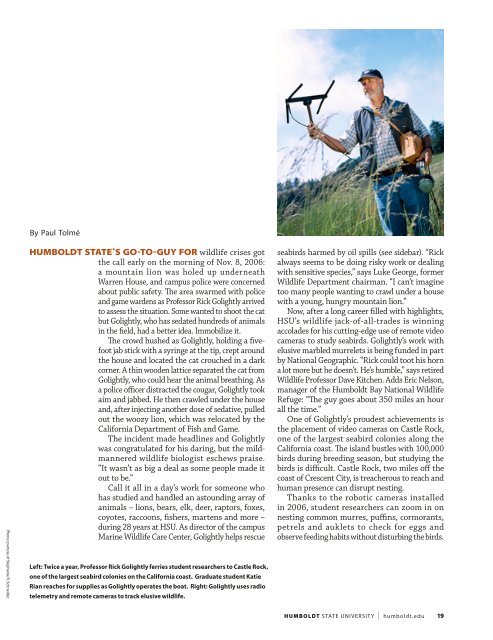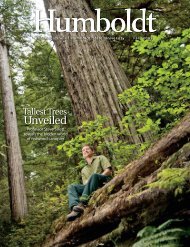Download Now - Humboldt Magazine - Humboldt State University
Download Now - Humboldt Magazine - Humboldt State University
Download Now - Humboldt Magazine - Humboldt State University
You also want an ePaper? Increase the reach of your titles
YUMPU automatically turns print PDFs into web optimized ePapers that Google loves.
Photo courtesy of Stephanie R. Schneider<br />
By Paul Tolmé<br />
HUMBOLDT STATE . S GO-TO-GUY FOR wildlife crises got<br />
the call early on the morning of Nov. 8, 2006:<br />
a mountain lion was holed up underneath<br />
Warren House, and campus police were concerned<br />
about public safety. The area swarmed with police<br />
and game wardens as Professor Rick Golightly arrived<br />
to assess the situation. Some wanted to shoot the cat<br />
but Golightly, who has sedated hundreds of animals<br />
in the field, had a better idea. Immobilize it.<br />
The crowd hushed as Golightly, holding a fivefoot<br />
jab stick with a syringe at the tip, crept around<br />
the house and located the cat crouched in a dark<br />
corner. A thin wooden lattice separated the cat from<br />
Golightly, who could hear the animal breathing. As<br />
a police officer distracted the cougar, Golightly took<br />
aim and jabbed. He then crawled under the house<br />
and, after injecting another dose of sedative, pulled<br />
out the woozy lion, which was relocated by the<br />
California Department of Fish and Game.<br />
The incident made headlines and Golightly<br />
was congratulated for his daring, but the mildmannered<br />
wildlife biologist eschews praise.<br />
“It wasn’t as big a deal as some people made it<br />
out to be.”<br />
Call it all in a day’s work for someone who<br />
has studied and handled an astounding array of<br />
animals – lions, bears, elk, deer, raptors, foxes,<br />
coyotes, raccoons, fishers, martens and more –<br />
during 28 years at HSU. As director of the campus<br />
Marine Wildlife Care Center, Golightly helps rescue<br />
Left: Twice a year, Professor Rick Golightly ferries student researchers to Castle Rock,<br />
one of the largest seabird colonies on the California coast. Graduate student Katie<br />
Rian reaches for supplies as Golightly operates the boat. Right: Golightly uses radio<br />
telemetry and remote cameras to track elusive wildlife.<br />
seabirds harmed by oil spills (see sidebar). “Rick<br />
always seems to be doing risky work or dealing<br />
with sensitive species,” says Luke George, former<br />
Wildlife Department chairman. “I can’t imagine<br />
too many people wanting to crawl under a house<br />
with a young, hungry mountain lion.”<br />
<strong>Now</strong>, after a long career filled with highlights,<br />
HSU’s wildlife jack-of-all-trades is winning<br />
accolades for his cutting-edge use of remote video<br />
cameras to study seabirds. Golightly’s work with<br />
elusive marbled murrelets is being funded in part<br />
by National Geographic. “Rick could toot his horn<br />
a lot more but he doesn’t. He’s humble,” says retired<br />
Wildlife Professor Dave Kitchen. Adds Eric Nelson,<br />
manager of the <strong>Humboldt</strong> Bay National Wildlife<br />
Refuge: “The guy goes about 350 miles an hour<br />
all the time.”<br />
One of Golightly’s proudest achievements is<br />
the placement of video cameras on Castle Rock,<br />
one of the largest seabird colonies along the<br />
California coast. The island bustles with 100,000<br />
birds during breeding season, but studying the<br />
birds is difficult. Castle Rock, two miles off the<br />
coast of Crescent City, is treacherous to reach and<br />
human presence can disrupt nesting.<br />
Thanks to the robotic cameras installed<br />
in 2006, student researchers can zoom in on<br />
nesting common murres, puffins, cormorants,<br />
petrels and auklets to check for eggs and<br />
observe feeding habits without disturbing the birds.<br />
HUMBOLDT STATE UNIVERSITY | humboldt.edu<br />
19




